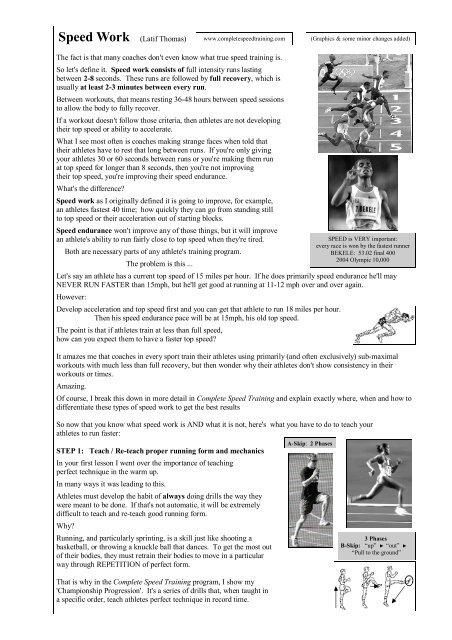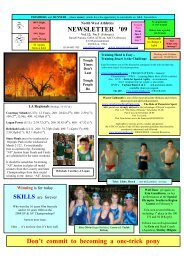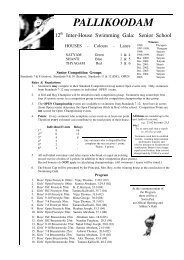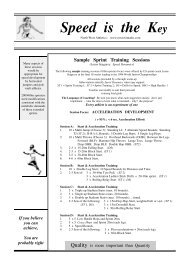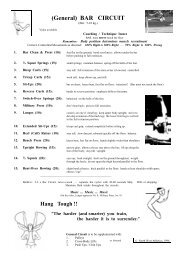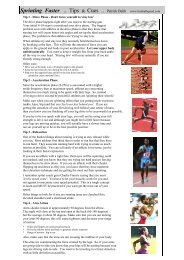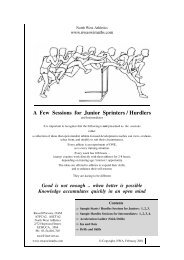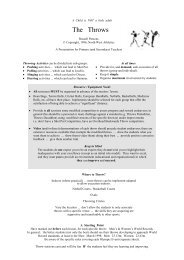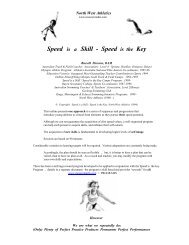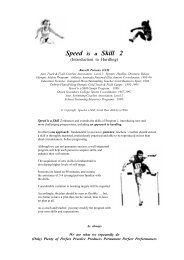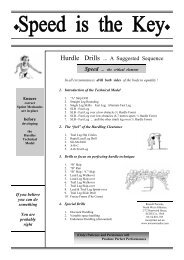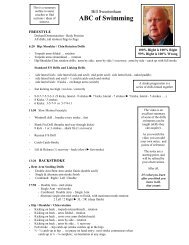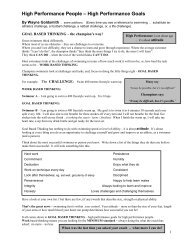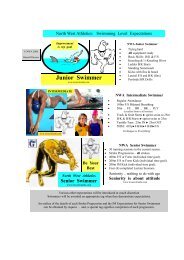Speed Work (Latif Thomas)
Speed Work (Latif Thomas)
Speed Work (Latif Thomas)
You also want an ePaper? Increase the reach of your titles
YUMPU automatically turns print PDFs into web optimized ePapers that Google loves.
<strong>Speed</strong> <strong>Work</strong> (<strong>Latif</strong> <strong>Thomas</strong>)<br />
www.completespeedtraining.com<br />
(Graphics & some minor changes added)<br />
The fact is that many coaches don't even know what true speed training is.<br />
So let's define it. <strong>Speed</strong> work consists of full intensity runs lasting<br />
between 2-8 seconds. These runs are followed by full recovery, which is<br />
usually at least 2-3 minutes between every run.<br />
Between workouts, that means resting 36-48 hours between speed sessions<br />
to allow the body to fully recover.<br />
If a workout doesn't follow those criteria, then athletes are not developing<br />
their top speed or ability to accelerate.<br />
What I see most often is coaches making strange faces when told that<br />
their athletes have to rest that long between runs. If you're only giving<br />
your athletes 30 or 60 seconds between runs or you're making them run<br />
at top speed for longer than 8 seconds, then you're not improving<br />
their top speed, you're improving their speed endurance.<br />
What's the difference?<br />
<strong>Speed</strong> work as I originally defined it is going to improve, for example,<br />
an athletes fastest 40 time; how quickly they can go from standing still<br />
to top speed or their acceleration out of starting blocks.<br />
<strong>Speed</strong> endurance won't improve any of those things, but it will improve<br />
an athlete's ability to run fairly close to top speed when they're tired.<br />
Both are necessary parts of any athlete's training program.<br />
The problem is this ...<br />
Let's say an athlete has a current top speed of 15 miles per hour. If he does primarily speed endurance he'll may<br />
NEVER RUN FASTER than 15mph, but he'll get good at running at 11-12 mph over and over again.<br />
However:<br />
Develop acceleration and top speed first and you can get that athlete to run 18 miles per hour.<br />
Then his speed endurance pace will be at 15mph, his old top speed.<br />
The point is that if athletes train at less than full speed,<br />
how can you expect them to have a faster top speed?<br />
It amazes me that coaches in every sport train their athletes using primarily (and often exclusively) sub-maximal<br />
workouts with much less than full recovery, but then wonder why their athletes don't show consistency in their<br />
workouts or times.<br />
Amazing.<br />
Of course, I break this down in more detail in Complete <strong>Speed</strong> Training and explain exactly where, when and how to<br />
differentiate these types of speed work to get the best results<br />
So now that you know what speed work is AND what it is not, here's what you have to do to teach your<br />
athletes to run faster:<br />
STEP 1: Teach / Re-teach proper running form and mechanics<br />
In your first lesson I went over the importance of teaching<br />
perfect technique in the warm up.<br />
In many ways it was leading to this.<br />
Athletes must develop the habit of always doing drills the way they<br />
were meant to be done. If that's not automatic, it will be extremely<br />
difficult to teach and re-teach good running form.<br />
Why?<br />
Running, and particularly sprinting, is a skill just like shooting a<br />
basketball, or throwing a knuckle ball that dances. To get the most out<br />
of their bodies, they must retrain their bodies to move in a particular<br />
way through REPETITION of perfect form.<br />
That is why in the Complete <strong>Speed</strong> Training program, I show my<br />
'Championship Progression'. It's a series of drills that, when taught in<br />
a specific order, teach athletes perfect technique in record time.<br />
A-Skip: 2 Phases<br />
SPEED is VERY important:<br />
every race is won by the fastest runner<br />
BEKELE: 53.02 final 400<br />
2004 Olympic 10,000<br />
3 Phases<br />
B-Skip: “up” ► “out” ►<br />
“Pull to the ground”
The order is critical because one drill builds upon the previous one, thus 'cementing' the proper positioning into place.<br />
Teach your athletes how to do these drills with perfect form and you will see it carry over to their speed work and<br />
performances almost immediately.<br />
STEP 2: 'Step over the opposite knee, drive the foot down into the ground'<br />
That's it. I just gave you the golden ticket.<br />
Teach your athletes to do this with power and authority and nothing will<br />
ever be the same again.<br />
Faster speeds come from applying more force to the ground; NOT from<br />
turning the legs over faster (although we aim to do both) .. and, NOT from taking longer strides.<br />
Stride frequency and stride length are by-products of the amount of force<br />
an athlete applies to the ground when running.<br />
Lots of coaches talk about 'driving the knees' when running. And they're right. Except that you need to drive the knee<br />
down into the ground, not up.<br />
Most people are teaching it backwards … and going backwards is the longest path to the finish line.<br />
When you teach your athletes the drills I pointed out in Step 1, they are learning the motion of 'step over, drive down'.<br />
Once that motion becomes automatic through perfect repetition, it's time to teach them to drive the foot down into the<br />
ground, using the legs more like pistons and less like they are riding a bike.<br />
Now it's time to see if they can apply these techniques while running.<br />
The best way to work on acceleration is to put athletes in a position where they really have to 'step over and drive<br />
down'. That's why I like to run speed workouts up short, fairly steep hills. Because of the angle of the incline,<br />
if athletes don't drive down trying to push the ground back and away from them, they simply won't gain any<br />
momentum going up the hill.<br />
If you can't use a hill, you can have them start from various positions on<br />
the ground. It's almost as good as a hill and athletes have fun competing<br />
against each other, e.g. reaction starts (prone position, react to coach “Go”, sprint to 30m.).<br />
It's tough to accurately explain it in words, but once you hear me talk about it while<br />
watching it done on video, you'll know exactly what to do with your athletes.<br />
Step 3: Critique form during workouts<br />
In theory I shouldn't have to say this, but coaches rarely do it beyond<br />
saying something vague like 'Swing your arms' or 'Drive your knees'.<br />
Comments like that have little value unless athletes know why they are<br />
supposed to do it.<br />
Since this method of training will be new to your athletes, they're going<br />
to need the aid of your watchful eye in order to make mid-practice changes to their form.<br />
If you neglect to do this during their workouts, then everything that came before it, in large part, was wasted.<br />
There are common errors that I see in athletes regardless of age, skill level, experience, sport or gender. At your next<br />
practice, make an effort to see if you can pick these issues out and instruct your athletes on ways to fix them.<br />
Remember that the cause of each of these problems is easily corrected. But until that happens, they're just slowing<br />
athletes down.<br />
Here are the 5 most common form problems that I see, in no particular order:<br />
Encourage young athletes<br />
to seek improvement in<br />
fundamental form elements<br />
1. Arms swinging across the midline of the body.<br />
2. Tightly clenched fists, arms, neck and face.<br />
3. Too much 'backside mechanics' - a lot of leg movement taking place<br />
behind the body, but not much going on in front of the body.<br />
4. 'Reaching' - foot strike takes place out in front of the body resulting in<br />
the shoulders being slightly behind the hips instead of directly above<br />
or slightly in front of the hips.<br />
5. Running heel to toe - the heels should never hit the ground during speed work.<br />
Plenty of drills<br />
Plenty of variation<br />
Plenty of Patience<br />
and Plenty of Praise<br />
Produces Positive Progression<br />
After all:<br />
- it’s not how fast you perform,<br />
- it’s how well you perform.<br />
NWA has numerous PROGRAMS featuring the introduction of Drills and can assist your progression<br />
towards a more efficient and effective running form: e.g.<br />
www.nwaswimaths.com: PROGRAMS > Athletics Programs > Intro to Drills<br />
> NWA—Basic Drills<br />
Please do not complain that help not sought is unavailable<br />
There are<br />
many more.<br />
It’s up to you.


